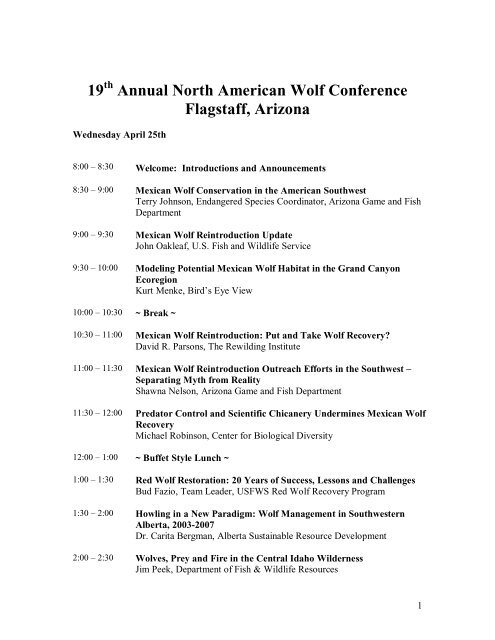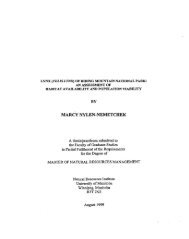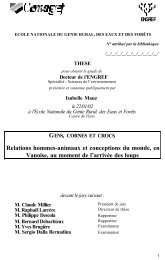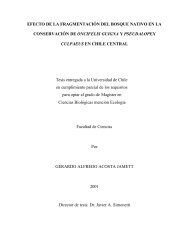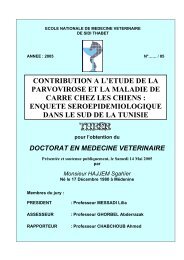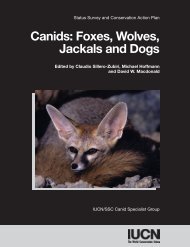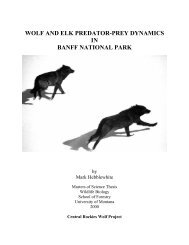Annual North American Wolf Conference Flagstaff, Arizona
Annual North American Wolf Conference Flagstaff, Arizona
Annual North American Wolf Conference Flagstaff, Arizona
Create successful ePaper yourself
Turn your PDF publications into a flip-book with our unique Google optimized e-Paper software.
19 th <strong>Annual</strong> <strong>North</strong> <strong>American</strong> <strong>Wolf</strong> <strong>Conference</strong><br />
<strong>Flagstaff</strong>, <strong>Arizona</strong><br />
Wednesday April 25th<br />
8:00 – 8:30<br />
Welcome: Introductions and Announcements<br />
8:30 – 9:00 Mexican <strong>Wolf</strong> Conservation in the <strong>American</strong> Southwest<br />
Terry Johnson, Endangered Species Coordinator, <strong>Arizona</strong> Game and Fish<br />
Department<br />
9:00 – 9:30 Mexican <strong>Wolf</strong> Reintroduction Update<br />
John Oakleaf, U.S. Fish and Wildlife Service<br />
9:30 – 10:00 Modeling Potential Mexican <strong>Wolf</strong> Habitat in the Grand Canyon<br />
Ecoregion<br />
Kurt Menke, Bird’s Eye View<br />
10:00 – 10:30 ~ Break ~<br />
10:30 – 11:00 Mexican <strong>Wolf</strong> Reintroduction: Put and Take <strong>Wolf</strong> Recovery?<br />
David R. Parsons, The Rewilding Institute<br />
11:00 – 11:30 Mexican <strong>Wolf</strong> Reintroduction Outreach Efforts in the Southwest –<br />
Separating Myth from Reality<br />
Shawna Nelson, <strong>Arizona</strong> Game and Fish Department<br />
11:30 – 12:00 Predator Control and Scientific Chicanery Undermines Mexican <strong>Wolf</strong><br />
Recovery<br />
Michael Robinson, Center for Biological Diversity<br />
12:00 – 1:00 ~ Buffet Style Lunch ~<br />
1:00 – 1:30 Red <strong>Wolf</strong> Restoration: 20 Years of Success, Lessons and Challenges<br />
Bud Fazio, Team Leader, USFWS Red <strong>Wolf</strong> Recovery Program<br />
1:30 – 2:00 Howling in a New Paradigm: <strong>Wolf</strong> Management in Southwestern<br />
Alberta, 2003-2007<br />
Dr. Carita Bergman, Alberta Sustainable Resource Development<br />
2:00 – 2:30 Wolves, Prey and Fire in the Central Idaho Wilderness<br />
Jim Peek, Department of Fish & Wildlife Resources<br />
1
2:30 – 3:00 ~ Break ~<br />
3:00 – 3:30 <strong>Wolf</strong> Depredation Investigation and Reporting<br />
Rick Williamson, <strong>Wolf</strong> Specialist, USDA Wildlife Services, Idaho<br />
3:30 – 4:00 The French Connection<br />
Carter Niemeyer, Retired USFWS, Idaho<br />
4:00 – 4:30 Training Gray Wolves (Canis lupus) As Conservation Ambassadors at<br />
Busch Gardens Williamsburg<br />
Rob Yordi, Busch Gardens<br />
Beginning at<br />
7:00<br />
Thursday April 26th<br />
Alpha Award Banquet Dinner with our 2007 keynote speaker:<br />
Vic Van Ballenberghe, University of Alaska -- Predator Control,<br />
Politics and Wildlife Management in Alaska<br />
Alpha Award for 2006 presented by The <strong>Wolf</strong> Recovery Foundation.<br />
Live Auction (with Rick Williamson) and Silent Auction benefiting<br />
nonlethal western wolf management efforts.<br />
8:00 – 8:30 The New Range War<br />
Rob Edward, Carnivore Restoration Program Director, Sinapu<br />
8:30 – 9:00 Evaluation of Global Positioning System Collars to Study Mexican Gray<br />
Wolves in the Blue Range <strong>Wolf</strong> Recovery Areas<br />
Dan Stark, USFWS, Mexican <strong>Wolf</strong> Recovery Program<br />
9:00 – 9:30 Addressing Social Concerns and Moving Mexican <strong>Wolf</strong> Reintroduction<br />
Efforts Forward - Mexican <strong>Wolf</strong> / Livestock Interdiction Program: A<br />
Concept<br />
Jose Viramontes, Southwest Region, USFWS<br />
9:30 – 10:00 Genealogy and Genetic Viability of the Gray Wolves of Yellowstone<br />
National Park<br />
Bridgett vonHoldt, University of California, Ecology and Evolutionary<br />
Biology<br />
10:00 – 10:30 ~ Break ~<br />
2
10:30 – 11:00 Partnerships in the Development of a Captive <strong>Wolf</strong> Population to make<br />
possible Mexican <strong>Wolf</strong> Recovery in the Wild<br />
Peter Siminski, The Living Desert & Patrick Valentino, California <strong>Wolf</strong> Ctr.<br />
11:00 – 11:30 Federal <strong>Wolf</strong> Delisting in the <strong>North</strong>ern Rockies: a Chronology of<br />
Questionable Actions<br />
Amaroq Weiss, Defenders of Wildlife<br />
11:30 – 12:00 Ethics and Wolves<br />
Bill Lynn, Tufts University, Center for Animals and Public Policy<br />
12:00 – 1:00 ~ Buffet Style Lunch ~<br />
1:00 – 1:30 Cracker Shells, All-nighters, and Big White Dogs: Five Years of Living<br />
With Wolves and Other Predators on a Large Range Sheep Operation in<br />
Idaho<br />
Mike Stevens, Lava Lake Land and Livestock<br />
1:30 – 2:00 Wolves and Ranching: Proactive Efforts to Reduce Conflicts in the USA<br />
<strong>North</strong>ern Rockies<br />
Suzanne Stone, Defenders of Wildlife<br />
2:00 – 2:30<br />
~ Break ~<br />
2:30 – 4:30 Non-Lethal Panel<br />
Lane Adamson, Carter Niemeyer, Mike Stevens, Suzanne Stone, Rick<br />
Williamson<br />
4:30 – 4:50 Closing Comments and Discussion<br />
Thank you and see you all next year. The 2008 <strong>North</strong> <strong>American</strong> <strong>Wolf</strong> <strong>Conference</strong> will be<br />
held April 7 – 11, 2008 and we will be back at Chico Hot Springs, Montana. Please contact<br />
Laura Jones at ljones@defenders.org for more information.<br />
Friday April 27th -- Grand Canyon Field Trip<br />
For those registered, the Grand Canyon field trip vans will depart Little America main lobby<br />
at 7:00 am and will return 3:00 pm. Sack breakfast and sack lunches are provided. Please<br />
dress for the weather (layers are best), wear good walking shoes, and bring your own<br />
binoculars, sunscreen (hopefully needed), and water. For more information, please contact<br />
Craig Miller at cmiller@defenders.org or 520-623-9653.<br />
3
Wednesday 8:30 – 9:00 am<br />
19 th <strong>Annual</strong> <strong>North</strong> <strong>American</strong> <strong>Wolf</strong> <strong>Conference</strong><br />
Abstracts<br />
In Order of Appearance<br />
Mexican <strong>Wolf</strong> Conservation in the <strong>American</strong> Southwest<br />
Terry B. Johnson, Endangered Species Coordinator, <strong>Arizona</strong> Game and Fish Department,<br />
2221 West Greenway Road, Phoenix, <strong>Arizona</strong> 85023-4399, (602) 789-3707, Fax (602) 789-<br />
3926, teebeej@azgfd.gov<br />
Wolves in the Southwest once occupied a land largely unfragmented by human presence. From<br />
Durango and Michoacan north through Chihuahua and Sonora, El Lobo roamed at will,<br />
although the middle elevations of 3000 to 6000 feet were likely its stronghold. Oak-studded hills<br />
and pine-oak forested mountains separated by grass-covered valleys characterized wolf habitat,<br />
in which long ridges and rocky outcrops providing denning sites galore. Farther north, in<br />
<strong>Arizona</strong> and New Mexico into southern Utah and Colorado, historical wolf country was very<br />
similar: oak, pine-oak, and pine woodland and forest were typical haunts. Before the frontier<br />
was conquered, free-flowing streams cut the narrow canyons and rivers dissected the lands<br />
below. Water, cover, and prey were plentiful, and the wolf thrived. But, as the 1800s gave rise<br />
to an increasingly settled West, conflicts emerged that led to systematic elimination of freeranging<br />
wolves. In the early 1900s, several subspecies of western wolves were eliminated<br />
entirely, and the Mexican wolf was driven deeper and deeper into Mexico. By the 1970s,<br />
estimates of wild Mexican wolves centered on 50 or fewer. From 1977 to 1980, five of the<br />
remaining wild animals in Mexico were trapped and brought into captivity to start a captive<br />
breeding program. The captures marked the beginning of recovery, and eventually<br />
reintroduction, efforts that are today as controversial as any wildlife program anywhere.<br />
In sharp contrast to many other endangered species, the Mexican wolf’s story is not about<br />
habitat destruction and inevitably shrinking wildlife populations. Habitat is not and never has<br />
been the biggest problem for wolves. Instead, the major issue is and always will be whether<br />
humans will share the landscape in such a way that wolves can persist. In this case, sharing<br />
means accepting, and where possible mitigating, inevitable human conflicts stemming from<br />
livestock and big game depredation, nuisance wolves, and wolf control. It means finding room<br />
on an increasingly fragmented landscape for an animal that by its very nature fails to recognize<br />
boundaries imposed by humans. At the core of the controversy are huge differences in human<br />
understanding, acceptance, and values, with state, federal, and tribal agencies obligated to<br />
manage the conflicts and try to find common ground among widely disparate interests. The<br />
controversy also revolves around basic questions of how many wolves, and where should they<br />
be? The media would say the most common answers to those questions are “not even one” and<br />
“definitely not in my back yard,” or “as many as possible” and “everywhere they want to be.”<br />
Both extremes are unrealistic, but the public has never been obligated to be realistic, especially<br />
about wolf management. This presentation provides a personal perspective on Mexican wolf<br />
conservation from 1982 through 2006, a relatively brief moment in the never-ending wolf wars<br />
of the <strong>American</strong> Southwest.<br />
Wednesday 9:00 – 9:30 am<br />
4
Mexican <strong>Wolf</strong> Reintroduction Update<br />
John K. Oakleaf 1 , John Morgart 1 , Daniel W. Stark 1 , Dan Groebner 2 , Saleen M. Richter 3 , and<br />
Krista Beazley 4 ( 1 U.S. Fish and Wildlife Service, P.O. Box 856, Alpine, AZ 85920, (928) 339-<br />
4329, John_Oakleaf@fws.gov, 2 <strong>Arizona</strong> Game and Fish Dept, 3 New Mexico Dept of Game<br />
and Fish, 4 White Mountain Apache Tribe)<br />
We will report the progress of field efforts from 1998-2006 to reestablish Mexican wolves<br />
(Canis lupus baileyi) into the Blue Range <strong>Wolf</strong> Reintroduction Area (BRWRA). The<br />
reintroduction area encompasses approximately 9,290 mi 2 , composed of the Apache-<br />
Sitgreaves National Forests (A-SNF) and the Fort Apache Indian Reservation (FAIR) in<br />
east-central <strong>Arizona</strong> and the Gila National Forest (GNF) in west-central New Mexico. The<br />
primary goal of this reintroduction effort is to restore a self-sustaining population of about<br />
100 wild Mexican wolves distributed across the BRWRA. In January 1998, the first Mexican<br />
wolves were released into <strong>Arizona</strong>. At the end of 2006, a minimum of 59 wolves in 12<br />
groups and seven breeding pairs could be confirmed inhabiting areas of <strong>Arizona</strong> and New<br />
Mexico. Further, an increased number of second-generation wild born pups are being<br />
produced in the population. However, several changes in the reintroduction program may<br />
increase the ultimate success of wolves in the area.<br />
Wednesday 9:30 – 10:00 am<br />
Modeling Potential Mexican <strong>Wolf</strong> Habitat in the Grand Canyon Ecoregion<br />
Kurt Menke 1 , Paul Sneed 2 , Larry Stevens 3 , Nicole Corbo 4 , Kelly Burke 3 and Kim Crumbo 3<br />
( 1 Bird’s Eye View, GIS Services, 3016 Santa Clara SE, Albuquerque, NM 87106, voice (505)<br />
265-0243, cell (505) 362-1776, kurt@birdseyeviewgis.com, 2 Prescott College, 4906 Box<br />
Canyon Rd, Billings, MT 59101, 3 Grand Canyon Wildlands Council, PO Box 1594, <strong>Flagstaff</strong>,<br />
AZ 86002, 4 Coordinator, Grand Canyon <strong>Wolf</strong> Recovery Project, P.O. Box 1594, <strong>Flagstaff</strong>,<br />
AZ 86002)<br />
The Gray <strong>Wolf</strong> (Canus lupus) historically inhabited much of the Grand Canyon Ecoregion<br />
but has been extirpated for much of the last century. The 36 million-acre Grand Canyon<br />
Ecoregion is bounded on the west by the Grand Wash, on the east by the Little Colorado<br />
River, and extends from the Mogollon Rim in central <strong>Arizona</strong> north to southern Utah’s High<br />
Plateau’s. As part of an ongoing effort to rewild this region, Grand Canyon Wildlands<br />
Council generated a GIS-based static wolf habitat suitability model. The results will be used<br />
to estimate what portions of the ecoregion can potentially support wolves under current<br />
conditions. The model was based on four assumptions: 1) wolves are habitat generalists<br />
whose main habitat requirement is prey, 2) they require remote areas with little human<br />
disturbance, 3) they tend to hunt in packs pursuing their prey and thus prefer flatter terrain,<br />
and 4) the ecoregion is an arid environment and availability of surface water is a limiting<br />
factor. The model used elk and mule deer density to represent available prey. Three datasets<br />
were used to represent human impact to the landscape: roads, population density, and land<br />
ownership. Slope and proximity to water were used to represent the final assumptions.<br />
These data were weighted and combined in an arithmetic overlay using ArcGIS 9.1. The<br />
resulting grid was classified into core habitat, minimum patch habitat, and dispersal areas.<br />
One core area was identified measuring nearly 7,000km 2 along with 12,000km 2 of minimum<br />
patch areas, and 24,000 km 2 of dispersal areas.<br />
5
Wednesday 10:30 – 11:00 am<br />
Mexican <strong>Wolf</strong> Reintroduction: Put and Take <strong>Wolf</strong> Recovery?<br />
David R. Parsons 1 , Jean C. Ossorio 2 , ( 1 Carnivore Conservation Biologist, The Rewilding<br />
Institute, 8613 Horacio Place NE, Albuquerque, NM 87111, (505) 275-1944,<br />
pbc@cybermesa.com, 2 Southwest Environmental Center, 275 <strong>North</strong> Downtown Mall, Las<br />
Cruces, NM 88001)<br />
Mexican wolves were first released into the Blue Range <strong>Wolf</strong> Recovery Area in 1998.<br />
According to pre-project projections, the end of 2006 was to be the point in time that the<br />
Blue Range Mexican wolf reintroduction project reached its objective of 102 wolves and 18<br />
successfully breeding packs. Instead the official population estimate is 57 wolves and 5<br />
breeding pairs (using a strict application of the official definition). As a comparative<br />
measure of the lack of progress toward reintroduction objectives, the population estimate at<br />
the end of 2003 was 55 wolves and 4 breeding pairs. One key difference between the<br />
proposed and actual projects is the time frame and number of new releases of wolves. The<br />
proposal anticipated the release of about 66 wolves from 1998 through 2002. Unsustainable<br />
failure rates (mortalities plus removals) have necessitated ongoing releases of wolves through<br />
2006, with the number of released wolves now totaling 99. We present a hypothetical<br />
population trend as if no new wolves were released after 2002 to offer a more accurate<br />
comparison between projected and actual results and to assess the capacity of the wild<br />
population to increase in the absence of new releases under current management practices.<br />
We present guidelines for future scenarios that would achieve the reintroduction project<br />
objective under two pre-selected rates of population increase. Recommendations are offered<br />
to the Mexican <strong>Wolf</strong> Adaptive Management Oversight Committee for timely achievement of<br />
the Mexican wolf reintroduction project objective.<br />
Wednesday 11:00 – 11:30 am<br />
Mexican <strong>Wolf</strong> Reintroduction Outreach Efforts in the Southwest – Separating Myth<br />
from Reality<br />
Shawna Nelson, <strong>Arizona</strong> Game and Fish Department, Mexican <strong>Wolf</strong> Reintroduction<br />
Project, P.O. Box 856, Alpine, <strong>Arizona</strong>, 85920, SNelson@azgfd.gov<br />
The reintroduction of an endangered species is difficult enough from a biological standpoint<br />
– but when dealing with a highly controversial animal, such as the Mexican wolf that may<br />
involve potential human/wolf conflict, the effort becomes exceedingly more difficult and<br />
complex. This is especially so when public attitudes and “crisis” wolf-related issues come in<br />
to play. The objective, therefore, of the Mexican wolf outreach program is to provide<br />
timely, accurate, innovative, unbiased information and encourage two-way communication<br />
between and among cooperating agencies and the public to ensure that cooperators and the<br />
public are aware of the issues and activities of concern to them. The program’s focus is on<br />
providing information that enables listeners and readers to draw their own conclusions about<br />
wolf reintroduction. Various information dissemination methods are used and include, but<br />
are not limited to, the following: presentations to and interactions with specific organizations<br />
and individuals, news releases, monthly project updates, Web site postings, natural history<br />
workshops, media interviews and one-on-one individual contacts with emphasis on residents<br />
and visitors in the reintroduction area. An increased tolerance for the reintroduction effort<br />
7
and of the wolves themselves, by the affected stakeholders, is the desired result of the<br />
outreach program. This program is committed to continual refinement of methods for and<br />
the facilitation of effective communication about the reintroduction project to the interested<br />
and affected public and to identify what should be communicated and how this information<br />
should be disseminated.<br />
Wednesday 11:30 – 12:00 pm<br />
Predator Control and Scientific Chicanery Undermines Mexican <strong>Wolf</strong> Recovery<br />
Michael J. Robinson, Center for Biological Diversity, P.O. Box 53166, Pinos Altos, NM<br />
88053, (505) 534-0360, michaelr@biologicaldiversity.org<br />
The 1996 EIS on Mexican gray wolf reintroduction to the Blue Range <strong>Wolf</strong> Recovery Area<br />
projected growth of the population to 102 wolves and 18 breeding pairs by Dec. 31, 2006. But<br />
the January 2007 government census found sign of only 59 wolves and 6 breeding pairs (plus a<br />
7 th pair that did not breed but is counted as such by the U.S. Fish and Wildlife Service).<br />
Government predator control largely accounts for the discrepancy between projected and actual<br />
wolf numbers. From 1998 through 2006, eight Mexican wolves were shot by the federal<br />
government, 20 more were killed unintentionally as a result of capture, and 24 wolves were<br />
captured and not re-released. Dozens more were captured and translocated, often traumatized<br />
and sometimes injured, resulting in established packs breaking up and individual wolves<br />
wandering widely in unfamiliar terrain. Two formal reviews of the reintroduction program came<br />
to sharply different conclusions as to population dynamics and concomitant recommendations<br />
for future management. The 2001 Three-Year Review, conducted by non-governmental<br />
biologists led by Paul C. Paquet, Ph.D., warned that removal levels were too high and predicted<br />
that the population would lag significantly behind projections unless key reforms to project<br />
regulations were enacted. The Paquet Report recommended two measures to obviate both the<br />
Fish and Wildlife Service’s legal obligation and its perceived social obligation to remove Mexican<br />
wolves: (1) allowing wolves to roam outside the arbitrary boundaries of the recovery area (just<br />
as all other endangered species managed by the Service are allowed, including wolves elsewhere);<br />
and (2) requiring ranchers to take some responsibility for removing or rendering inedible the<br />
carcasses of livestock not killed by wolves to prevent wolves from scavenging on them and<br />
becoming habituated to stock (similar to longstanding regulations for wolf recovery in the<br />
northern Rocky Mountains). The Service has not enacted either reform.<br />
The Five-Year Review, developed by agency insiders and formally accepted by the Service in<br />
2006 as the template for upcoming regulatory changes, recommends four contrary provisions<br />
that would perpetuate and even worsen the status quo in predator control: (1) no regulation of<br />
non-wolf-killed livestock carcasses; (2) broadening the circumstances in which private<br />
individuals could kill wolves; (3) applying the current (unsuccessful) wolf management protocols<br />
to all new areas made available for wolf occupation; and (4) allowing the states of <strong>Arizona</strong> and<br />
New Mexico and tribal authorities to cap the population of wolves in the bi-state area at just 125<br />
individuals and permit the killing of any and all wolves above that number — a number with no<br />
scientific basis and no relationship to long-term preservation or recovery of wolves in the<br />
Southwest.<br />
As justification, the Five-Year Review systematically under-represents and mischaracterizes<br />
the roles of (1) wolves scavenging in precipitating depredations, and (2) wolf translocations<br />
8
in killing wolves. Service documents obtained via the Freedom of Information Act reveal<br />
the results of the Service’s disregard for the Paquet Report’s warnings and<br />
recommendations, and indicate that the Five-Year Review’s recommendations, if enacted,<br />
will prevent recovery of the Mexican wolf altogether.<br />
Wednesday 1:00 – 1:30 pm<br />
Red <strong>Wolf</strong> Restoration: 20 Years of Success, Lessons and Challenges<br />
Bud Fazio, Team Leader, Red <strong>Wolf</strong> Recovery Program, USFWS ARNWR, Manteo, NC,<br />
(252) 473-1131 x 240, Cell (252) 305-1183, Buddy_Fazio@fws.gov<br />
The year 2007 marks 20 years of red wolves restored to the wild since 1987. Faced with<br />
near extinction during the 1960’s, biologists continue to meet the challenges of restoration<br />
year after year. We describe highlights from twenty years of pioneering efforts and lessons<br />
learned which contribute to today’s red wolf restoration success on the ground. We discuss<br />
survival success of wild vs. captive vs. island-reared wolves, as well as other techniques such<br />
as pup fostering, genetics and disease management. Human factors are addressed each year.<br />
We also briefly discuss today’s challenges and future activity.<br />
Wednesday 1:30 – 2:00 pm<br />
Howling in a New Paradigm: <strong>Wolf</strong> Management in SW Alberta, 2003-2007<br />
Carita Bergman, PhD, Senior Wildlife Biologist, Southern Rockies Area, Fish & Wildlife<br />
Division, Alberta Sustainable Resource Development, Box 1420, Pincher Creek, AB T0K<br />
1W0, (403) 627-1116, Fax: (403) 627-4316, carita.bergman@gov.ab.ca<br />
Agency management attitude towards wolves in Alberta has slowly shifted over the past<br />
century, showing a recent trend towards tolerance and conservation. Because of their high<br />
numerical abundance within the province of Alberta, however, wolves do not possess any<br />
protected status, regardless of local population structure. Moreover, regulations applicable to<br />
the killing of wolves and the lack of mortality quotas hamper management for stable<br />
populations. In contrast to northern Alberta, the band of wolf habitat in southwestern<br />
Alberta is so narrow in places that only a single pack can subsist between the Continental<br />
Divide and the cultivated prairie to the east, even under the best conditions. Because cattle<br />
ranching is a pervasive activity in SW Alberta, wolves had been intentionally eliminated from<br />
the landscape by mid-century to minimize their impact on ranching activities. Natural recolonization<br />
of wolves began to occur in the 1980’s, and as conflicts with ranching also<br />
grew, management interest increased. A multi-jurisdictional group formed in the early 1990’s<br />
to begin to gather more information on the SW Alberta wolf population, and begin work on<br />
a management plan for wolves in the area. This initiative came to a sudden halt when most<br />
of the wolf population was harvested in a single year, and all collared individuals were lost.<br />
In 2003, wolf-ranching conflicts were again on the increase, and a multi-stakeholder<br />
committee was formed to make recommendations to the management agency.<br />
Recommendations address all aspects of wolf management, with a focus on reducing wolfranching<br />
conflicts. A collaring program began shortly after the inception of the Oldman<br />
Basin Carnivore Advisory Group, and the use of Argos collars allowed instantaneous<br />
tracking of packs to assist not only in the collection of biologically relevant information, but<br />
9
also to help address conflicts that were occurring. The information obtained from our<br />
collaring program has helped to frame new management goals that are more widely accepted<br />
by participating groups. Collars have also allowed a new approach to lethal control that limits<br />
mortality within packs when conflicts are occurring, and assists in maintaining occupied<br />
territories. Active participation by several ranchers, both on the Advisory Group and in the<br />
field, had been key to our success. Opportunities for non-lethal control continue to be<br />
investigated where feasible. For continued success, urgent attention is needed in several<br />
areas: staff and funds, enhanced communication and participation within the local<br />
community, and area-specific hunting regulations that address local population needs.<br />
Wednesday 2:00 – 2:30 pm<br />
Wolves, Prey and Fire in the Central Idaho Wilderness<br />
James M. Peek, Department of Fish & Wildlife Resources, University of Idaho, Moscow, ID<br />
83844-1136, peek@uidaho.edu<br />
Ten years after the reintroduction of the gray wolf into central Idaho, enough information<br />
has accumulated to postulate on the effects of the wolf on its prey, bighorn sheep, elk, and<br />
mule deer. There are four Idaho Fish & Game hunting units, comprising 2.2 million acres,<br />
including the wolf reintroduction sites. Much of this area is within the Frank Church Riverof-No-Return<br />
Wilderness, where prescription wildfire has burned approximately 52% of the<br />
land. At least 15 wolf packs were estimated present winter 2006-7, with over 100 individuals<br />
in these packs. Bighorn sheep are not subject to substantial predation in this area. Mule<br />
deer populations, as indexed by the known hunter harvest, are increasing. Elk are declining<br />
in one hunting unit, increasing in one unit and fluctuating with no apparent trend in two<br />
units. Wildfire, summer drought, winter severity, and predation are the major factors that<br />
influence this ecosystem. An interpretation of trends in large mammal populations depends<br />
upon knowledge of how these factors affect the system.<br />
Wednesday 3:00 – 3:30 pm<br />
<strong>Wolf</strong> Depredation Investigation and Reporting<br />
Rick Williamson, <strong>Wolf</strong> Management Specialist, USDA-WS-Idaho, P.O. Box 465, Arco,<br />
Idaho, (208) 681-3127, lobo@ida.net<br />
Agency officials responsible for investigating reports of wolf predation on livestock must<br />
carefully observe and analyze available evidence to determine if in fact the animal was killed<br />
by a predator, and if so, what type of predator, or whether the animal's death was due to<br />
some cause other than predation. Presence or absence of subcutaneous hemorrhaging and<br />
tissue damage, size and spacing of canine puncture marks, presence of tracks, scat, drag<br />
marks, and/or other evidence might all potentially be used in determining cause of death.<br />
Careful documentation of available evidence is required in order to support decisions<br />
regarding compensation for damage. Various record-keeping forms may be used in different<br />
states, but documentation typically includes at a minimum the investigator's and the livestock<br />
owner's contact information, type and number of livestock reportedly killed, species of<br />
predator confirmed or likely to have caused the damage, and a narrative description of the<br />
physical evidence upon which conclusions are based.<br />
10
Wednesday 3:30 – 4:00 pm<br />
The French Connection<br />
Carter Niemeyer, Retired USFWS, Boise, Idaho 83705, (208) 338-7917,<br />
cjniemeyer@msn.com<br />
In 1992 wolves returned to the French Alps from Italy, thrilling many people, frustrating<br />
shepherds and nudging French government officials into action. Though their numbers are<br />
few, the wolves regularly killed sheep in Southern France’s rugged, remote areas surrounding<br />
Le Parc Mercantour, a French national park. French officials realized the need to assemble a<br />
protocol for dealing with depredating wolves. I was invited to help France develop wolfhandling<br />
protocol and demonstrate wolf capture techniques for their biologists. My mission:<br />
capture three wolves in the Alps and fit them with radio collars for scientific study. Though<br />
the wolves eluded capture, and I spoke no French, my guidance united French wildlife<br />
agencies and opened dialogue with other European countries, allowing them to take the first<br />
steps in their country’s history toward a scientific wolf program.<br />
Wednesday 4:00 – 4:30 pm<br />
Training Gray Wolves (Canis lupus) As Conservation Ambassadors at Busch<br />
Gardens Williamsburg<br />
Rob Yordi, Manager/Zoological Operations, Thad Lacinak, VP Animal Training, Busch<br />
Entertainment Corporation, Busch Gardens Williamsburg, One Busch Gardens Blvd.,<br />
Williamsburg, VA 23185, (757) 253-3083, fax (757) 253-3083,<br />
Robert.Yordi@buschgardens.org<br />
Busch Gardens Williamsburg currently houses 3.3 Adult Gray Wolves (Canis lupus) and 2.0<br />
Juvenile Arctic Wolves (Canis lupus arctos). The principles of animal training that have been<br />
developed for Marine Mammals by the SeaWorld Adventure Parks have been applied to the<br />
daily training of the wolves. Initially the idea to train the wolves in this fashion was met with<br />
skepticism but with the use of established methods the program has been very successful.<br />
The goal of the training program has been to present a conservation-based show for our<br />
guests that highlights the importance of the wolf in the environment and their current<br />
challenges. The animal training staff does not represent part of each pack but act as a<br />
neutral source of enrichment and food that the wolves voluntarily accomplish behaviors for.<br />
Training sessions with the wolves are done in both free contact and protected contact<br />
settings with a recall trainer for control. As a result of the successful animal training<br />
program the wolves are able to act as conservation ambassadors for over 2.5 million guests<br />
per year.<br />
2007 Keynote Speaker<br />
11
Predator Control, Politics, and Wildlife Conservation in Alaska<br />
Victor Van Ballenberghe, Department of Biology and Wildlife, University of Alaska<br />
Fairbanks, Fairbanks, AK 99775, vicvanb@alaska.com<br />
Lethal control programs aimed at reducing wolf (Canis lupus) and bear (Ursus arctos and U.<br />
americanus) numbers while attempting to increase densities of moose (Alces alces) and caribou<br />
(Rangifer tarandus) for hunters have occurred intermittently in Alaska, USA, for the past 3<br />
decades. These programs were accompanied by considerable controversy, much of it<br />
directed at methods of control including helicopter shooting by government employees,<br />
snaring, and fixed-wing aircraft shooting by private citizens. From 1976 to 1983, 1,300<br />
wolves were taken in several areas of Alaska by a combination of helicopter shooting and<br />
private trapping. Adverse public reaction largely restricted wolf control from 1984 to 1994<br />
when a snaring program again produced controversy and that control program was<br />
terminated. In 1997, a National Research Council review suggested numerous biological<br />
standards for Alaska’s predator control programs. The review strongly endorsed the<br />
approach of conducting predator control as adaptive management. Control proponents<br />
sponsored legislation in the 1990’s that mandated intensive management of certain depleted<br />
populations of ungulates deemed important for consumptive use by humans.<br />
The primary management tool to increase such populations is predator control. Intensive<br />
management also required setting population and harvest objectives for ungulates. These<br />
objectives often were based on historical highs that are now likely unattainable and almost<br />
certainly unsustainable. Implementation of intensive management programs involving<br />
reductions of black bears and brown bears as well as wolves has now been approved in 5<br />
areas of Alaska totaling about 60,000 square miles with up to 664 wolves scheduled to be<br />
shot by April 2007. Approval of additional programs is pending. Controversy now is<br />
focused not merely on ethical objections to methods of control, but extends to basic<br />
principles of wildlife conservation including sustainability of ungulate populations,<br />
protection of habitat integrity for ungulates, and population viability of predators.<br />
Recommended biological standards and guidelines for justifying, implementing, monitoring,<br />
and evaluating control programs are not being applied.<br />
~~~~~~~~~~~~~~~~~~~~~~~~~~~~~~~~~~~~<br />
Thursday 8:00 – 8:30 am<br />
The New Range War<br />
Rob Edward, Carnivore Restoration Program Director, Sinapu, 1911 11 th Street, Suite 103,<br />
Boulder, CO 80302, rob@sinapu.org<br />
As efforts to restore gray wolves (C. lupus) to the <strong>North</strong>ern Rocky Mountains move into a<br />
new phase, with managers now focused on the transition to de-listing and state management<br />
of the species, court rulings and conservation science indicate that more must be done to<br />
affect a range-wide recovery of wolves. Yet, current policy direction appears to be on a<br />
collision course with the courts and Congressional intent as expressed in the Endangered<br />
Species Act, setting the stage for a protracted fight over whether delisting is presently<br />
appropriate. At the heart of this debate is the way the U.S. Fish & Wildlife Service has<br />
chosen to define a key word: “range”. Depending upon the interpretation of that word, and<br />
12
the associated legal mandate of the Endangered Species Act to restore wolves to “all or a<br />
significant portion” of their range, wolf recovery may be considered complete, or the job<br />
may not be done yet. The legal and policy outcomes of this debate have far-reaching<br />
implications, not only for the future of wolves in <strong>North</strong> America, but also for the recovery<br />
of other imperiled species.<br />
13
Thursday 8:30 – 9:00 am<br />
Evaluation of Global Positioning System Collars to Study Mexican Gray Wolves in<br />
the Blue Range <strong>Wolf</strong> Recovery Area<br />
Daniel W. Stark 1 , Paul R. Krausman 2 , John K. Oakleaf 3 , John R. Morgart4,<br />
( 1 Wildlife Biologist, USFWS, Mexican <strong>Wolf</strong> Recovery Program, P.O. Box 856,<br />
Alpine, AZ 85920, (928) 339-4329, dan_stark@fws.gov, 2 University of <strong>Arizona</strong>, Tucson, AZ,<br />
3 U.S. Fish and Wildlife Service, Alpine, AZ, 4 U.S. Fish and Wildlife Service, Albuquerque,<br />
NM)<br />
We used global positioning system (GPS) collars to collect biological information of<br />
Mexican gray wolves (Canis lupus baileyi) in the Blue Range <strong>Wolf</strong> Recovery Area (BRWRA) of<br />
east central <strong>Arizona</strong> and southwestern New Mexico. We evaluated GPS collar performance,<br />
home range, prey selection, and kill rates, during different times of the year, between June<br />
2005 and March 2007. The primary prey of wolves in summer and winter was elk. Wolves<br />
selected for elk calves and against cow and bull elk in proportion to their availability. The use<br />
of GPS collars is an effective method to collect data on ungulate kills and other biological<br />
information (e.g., collar performance, home range, and kill rates) about Mexican gray wolves<br />
in the BRWRA. With increased performance of GPS collar technology, researchers will be<br />
able to assess the impacts of Mexican gray wolves on ungulate populations in the BRWRA<br />
and address concerns of the public.<br />
14
Thursday 9:00 – 9:30 am<br />
Addressing Social Concerns and Moving Mexican <strong>Wolf</strong> Reintroduction Efforts<br />
Forward - Mexican <strong>Wolf</strong> / Livestock Interdiction Program: A Concept<br />
Jose Viramontes, Congressional Liaison, USFWS, Southwest Region<br />
(505) 248-6404 Office. jose_viramontes@fws.gov http://southwest.fws.gov<br />
The ultimate goal for the Fish and Wildlife Service in Mexican wolf reintroduction efforts is<br />
the eventual recovery of this native species. Recognizing that there are a number of barriers<br />
to achieving this goal, the Service is working with all involved entities to overcome those<br />
barriers. Some barriers are based in biology, while others are of a more sociological nature.<br />
One such barrier is the financial impact caused when wolves kill livestock that are on private<br />
lands or are legally present on grazing allotments. Building on the success of the Defenders<br />
of Wildlife Bailey Wildlife Foundation <strong>Wolf</strong> Compensation Trust and Proactive Carnivore<br />
Conservation Fund the Service is currently exploring the development of a non-federal<br />
interdiction program to provide economic relief to those experiencing a financial impact by<br />
Mexican wolf reintroduction. The concept is in the development stages but its ultimate<br />
success is directly dependant on the involvement and support of all involved entities.<br />
The concept includes a multi-faceted approach to addressing livestock depredations with the<br />
intent of limiting the occurrence of permanent removal of Mexican wolves. It outlines both<br />
proactive steps to discourage livestock depredation as well as reactive measures to address<br />
the financial concern associated with depredation. Potential funding sources and program<br />
managers are identified. The Service will continue to work with all interested parties to<br />
reintroduce and recover the Mexican wolf. In the spirit of cooperative conservation,<br />
successful reintroduction relies on a multi-partner approach. Whether working to address the<br />
concerns of the livestock industry or environmental organizations, Service efforts are always<br />
focused on successful reintroduction and eventual recovery of the Mexican wolf for the<br />
benefit of the <strong>American</strong> public.<br />
Thursday 9:30 – 10:00 am<br />
Genealogy and Genetic Viability of the Gay Wolves (Canis lupus) of Yellowstone<br />
National Park<br />
B. M. vonHoldt 1 , D. R. Stahler 1,2 , D. W. Smith 2 , D. A. Earl 1 , J. P. Pollinger 1 and R. K.<br />
Wayne 1 , ( 1 University of California, Los Angeles, Ecology and Evolutionary Biology, 621<br />
Charles E. Young Dr. South, Los Angeles, CA 90095, (310) 825-5014, bvonhold@ucla.edu,<br />
2 Yellowstone Center for Resources, National Park Service, P.O. Box 168, Yellowstone<br />
National Park, Wyoming 82190)<br />
We discuss the genealogy and genetic viability of the reintroduced population of gray wolves<br />
in Yellowstone National Park (YNP). The gray wolf was reintroduced to YNP in 1995 and<br />
1996 with 31 founders from Alberta and British Columbia, Canada. Now, over 300 wolves<br />
exist in the Greater Yellowstone Ecosystem as a result of this successful recovery effort.<br />
Despite very limited gene flow from other wolf populations, we find that high levels of<br />
genetic diversity have been maintained during the reintroduction. Based on genetic analysis<br />
of 30 microsatellite loci and field data, we have produced a completely resolved genealogy of<br />
over 200 YNP wolves that elucidates the breadth and variety of social dynamics within the<br />
15
Yellowstone population. Despite currently high levels of variation, there is concern for<br />
maintaining the genetic health over the long-term given the lack of connectivity with other<br />
populations. Population-based simulations provide a pessimistic outlook for genetic viability<br />
of the Greater Yellowstone wolf population if the population is isolated and not maintained<br />
at high numbers.<br />
Thursday 10:30 – 11:00 am<br />
Partnerships in the Development of a Captive <strong>Wolf</strong> Population to make possible<br />
Mexican <strong>Wolf</strong> Recovery in the Wild<br />
Peter Siminski, The Living Desert, 47-900 Portola Avenue, Palm Desert, CA,<br />
psiminski@livingdesert.org, Patrick Valentino, (California <strong>Wolf</strong> Center & Mexican <strong>Wolf</strong><br />
Conservation Fund, PO Box 1389, Julian, CA 92036, patrick@californiawolfcenter.org)<br />
One of the first realizations of the newly formed Mexican wolf recovery team in the late<br />
1970s was that the Mexican wolf was about to become extinct in the wild and that no one<br />
could change this outcome. One of the first recommendations of the binational recovery<br />
team and one of the first binational actions was to capture as many wild Mexican wolves as<br />
possible and then hold and breed them in captivity until a day for re-establishment in the<br />
wild could be realized. The Mexican wolf went extinct in the wild in 1980. Today there are<br />
291 Mexican wolves in 48 captive facilities in the U.S. and Mexico, there are ten packs in a<br />
reintroduced population in <strong>Arizona</strong> and New Mexico, and Mexico is planning for<br />
reintroductions within Mexico. The robust captive population is the result of binational<br />
partnerships, government agency and non-government organization partnerships, and<br />
professional zoo, private animal holding facility and university partnerships. The principle<br />
organizing structure of the captive program today is the Association of Zoos and<br />
Aquarium’s Species Survival Plan program. This program provides systems for tracking<br />
captive pedigrees through a studbook, expertise in small population management with<br />
demographic and genetic conservation goals, husbandry and animal welfare guidelines, and<br />
planning and goal setting processes for species conservation outcomes.<br />
The activities of the holding facilities go beyond the holding and breeding of wolves, and<br />
preparing wolves for the wild. The educational displays and programs in the 48 institutions<br />
holding wolves are attended annually by over 20 million people. Research activities<br />
conducted at and by these institutions or in collaboration with universities provides direct<br />
conservation benefit to the Mexican wolf. Fundraising activities and contributions by the<br />
NGOs amount to millions of dollars annually to the benefit of Mexican wolf conservation.<br />
Thursday 11:00 – 11:30 pm<br />
Federal <strong>Wolf</strong> Delisting in the <strong>North</strong>ern Rockies: a Chronology of Questionable<br />
Actions<br />
Amaroq Weiss, Defenders of Wildlife, 258 A Street, Suite 16, Ashland, OR, 97520, (541)<br />
552-9653, aweiss@defenders.org<br />
In 1995, after a 70-year absence from the region, wolves were reintroduced to the northern<br />
Rockies. Five years later, the US Fish and Wildlife Service embarked on a series of efforts to<br />
remove federal wolf protections. A 2000 proposal to reclassify and delist wolves, finalized in<br />
16
2003, was overturned by court order in 2005. Prior to the ruling, 10(j) regulations governing<br />
wolves in Idaho and Montana were loosened, allowing broader lethal control of wolves and<br />
transitioning management prior to federal delisting. The Service responded to the court<br />
ruling with a near-instantaneous issuance of 10(a)(1)(A) permits to kill wolves for livestock<br />
depredations, subsequently halted in a separate court decision.<br />
With its February 2007 proposal, the Service now stands poised to delist wolves in a Distinct<br />
Population Segment (DPS) that includes the northern Rockies plus portions of adjacent<br />
states not included in the original recovery area. The DPS boundaries are legally<br />
questionable, inconsistent, and dismiss input from Washington, Oregon and Utah state<br />
agencies. While federal delisting in the region requires all three northern Rockies states to<br />
have approved wolf plans prior to delisting, only Montana’s provides a balanced,<br />
conservation-based approach. Idaho’s plan, legislative actions, agency proposals and<br />
governor’s rhetoric demonstrate it cannot be trusted to manage wolves. Wyoming’s state<br />
laws and wolf plan allow wolves to be shot on sight in 90% of the state, yet the Service has<br />
indicated it would approve a Wyoming plan with only slight modifications, if completed by<br />
May 1st. Recently, the Solicitor’s office for the Service released an opinion defining the term<br />
“significant portion of range” to relieve itself of responsibility for recovering species in<br />
places other than where they currently exist, and to forestall more legal defeats. Lastly, the<br />
Service will soon be proposing to modify 10(j) to further expand authority to kill wolves for<br />
killing other wildlife. The last seven years of Service proposals and actions regarding wolves<br />
in the northern Rockies seem to be based far more on politics than on science or federal law.<br />
Thursday 11:30 – 12:00 pm<br />
Ethics and Wolves<br />
William S. Lynn, PhD, Assistant Professor, Center for Animals and Public Policy, Tufts<br />
University, 200 Westboro Road, <strong>North</strong> Grafton, MA 01356, (508) 887-4570, fax (508) 839-<br />
3337, william.lynn@tufts.edu)<br />
Wolves are not the only way to explore the ethics of humanity’s relationship to animals.<br />
They have, nonetheless, a special resonance in many human cultures -- as beasts of waste<br />
and desolation, as vital ecological agents, as creatures exemplifying the best of humanity, as<br />
wild beings we can respect in all their familiarity and strangeness. Wolves move people, pro<br />
and con, and this opens up possibilities for dialogue about human-animal relations.<br />
From an ecological perspective, wolves are an indicator of landscape health. They are<br />
indispensable ‘top carnivores’ that promote the health of ecosystems, as well as a ‘flagship<br />
species’ whose cache helps protect or restore other animals and plants that are not so<br />
charismatic. Yet the ability of wolves to thrive in wild and humanized landscapes may also be<br />
a cogent indicator of our own moral health. If we can learn to live with wolves – large<br />
predators require substantial habitat and human tolerance – then we will per force have<br />
taken significant steps towards living in a sustainable manner. If this were to occur, wolves<br />
would be both one instance of, as well as a model for, our ability to coexist with a morethan-human<br />
world. The recovery and presence of wolves (and other predators) in a rapidly<br />
urbanizing and globalizing world raises old fears and new issues. Learning to share both<br />
natural and humanized landscapes with wolves is a difficult personal and cultural shift of<br />
perspective for some. It also entails real and unavoidable social and political conflict. We<br />
should expect such difficulties when we try to optimize the well-being of people and wolves.<br />
17
To help mitigate or resolve such conflict, we need an ethics of wolf recovery. This ethics<br />
should not only help reveal the moral issues at stake, but provide guidance on how we ought<br />
to live with wolves in a shared landscape. When speaking about ethics and wolves, one can<br />
get caught up in particular ethical theories and what they might say about wolves. This does<br />
little to advance our thinking. Ethics is not about rigid rules or dogmatic theories. It is really<br />
about the moral values that inform (or should inform) how we ought to live. With this in<br />
mind, this paper looks at several questions that have emerged in recent debates over<br />
humanity’s relationship to wolves.<br />
o What is the relationship between ethics, science and public policy?<br />
o Do wolves have intrinsic value?<br />
o Can changes in land use help us coexist with wolves?<br />
o Is the intrusive management of wolves justified?<br />
Getting our heads straight about ethics and wolves has never been more important. The<br />
moral-political landscape of wolf recovery has changed over the course of thirty years. It is a<br />
landscape where the assertions of anti-wolf interest groups are brazen, the junk science and<br />
regulatory mendacity of the current federal and many state administrations intentionally<br />
undermines conservation, and wolf management has become an excuse for a gulag of wolf<br />
‘parks’ surrounded by zones of species cleansing. Moreover, a policy focus on technical<br />
matter instead of practical ethics has resulted in a distorted vision of how and where we<br />
ought to live with wolves. This paper will explore this larger vision, contrasting the<br />
presuppositions that inform contemporary efforts at wolf recovery with a broader notion of<br />
what it means to live sustainably alongside wolves.<br />
Thursday 1:00 – 1:30 pm<br />
Cracker Shells, All-nighters, and Big White Dogs: Five Years of Living with Wolves<br />
and Other Predators on a Large Range Sheep Operation in Idaho<br />
Mike Stevens, President, Lava Lake Land & Livestock, LLC, P.O. Box 2249, Hailey, Idaho<br />
83333, (208) 788-1710 Office, (208) 720-2781 Mobile, (208) 788-1264 Fax,<br />
mike@lavalake.net, www.lavalakelamb.com<br />
Lava Lake Land & Livestock operates a range sheep operation on 850,000 acres of private,<br />
state, and federal lands in south-central Idaho. Founded in 1999 with a two-pronged mission<br />
to achieve landscape-scale conservation in the spectacular Pioneer Mountain-Craters of the<br />
Moon region and to support its conservation work through environmentally sound business<br />
practices, Lava Lake has received multiple conservation awards for its wide range of<br />
conservation and scientific projects and markets its own brand of all-natural and certified<br />
organic lamb. Since 2002, Lava Lake has worked with a coalition of conservation groups and<br />
agencies to develop proactive non-lethal methods to prevent predation of sheep by wolves,<br />
bears, coyotes, and mountain lions. While the risk of large predation events remains, we have<br />
successfully tested proactive methods of wolf deterrence with sheep bands in direct contact<br />
with wolf packs.<br />
18
Thursday 1:30 – 2:00 pm<br />
Wolves and Ranching: Proactive Efforts to Reduce Conflicts in the USA <strong>North</strong>ern<br />
Rockies<br />
Suzanne Asha Stone, Defenders of Wildlife, P.O. Box 773, Boise, ID 83702, (208) 424-9385,<br />
(208) 861-4655 Cell, (208) 424-0169 Fax, sstone@defenders.org<br />
The optimal way to manage conflicts between livestock owners and wolf conservationists is<br />
to proactively prevent wolf depredations on livestock by non-lethal means. This goal led to<br />
the creation of The Bailey Wildlife Foundation Proactive Carnivore Conservation Fund in<br />
1998, which supports the use of non-lethal deterrents and preventative animal husbandry<br />
practices including livestock guard dogs, electric night pens, fladry, task-specific range riders,<br />
alternative grazing, removal of attractants, and other methods. Many of these deterrents<br />
were developed in partnership with ranchers, and tribal, state and federal agencies. Working<br />
with livestock owners, resource managers and others to prevent or reduce predator<br />
problems has important conservation benefits. The single leading cause of wolf mortality in<br />
the western USA is government lethal control actions to stop livestock losses. Reducing<br />
conflicts can help protect wolves from being unnecessarily killed. Additionally, addressing<br />
these conflicts and implementing common-sense solutions creates opportunities for<br />
collaboration, which can help reduce social tension and encourage co-existence.<br />
Over the course of the program, we have conducted a wide range of proactive and nonlethal<br />
wolf projects throughout the region including several range rider projects in Montana,<br />
turbo-fladry development in central Idaho, grazing allotment retirement near Yellowstone<br />
National Park; supplementing livestock guard dogs on Idaho’s Boise, Payette and Sawtooth<br />
National Forests, and building predator proof fencing for llama protection near Missoula,<br />
19
Montana and sheep enclosures in the Paradise Valley in Montana. From these efforts, we<br />
developed general guidelines to help prioritize and manage potential projects, which include<br />
the project’s importance to species conservation, location, level of cooperation among<br />
participants, feasibility, evaluation and limitations. Please visit<br />
www.defenders.org/wildlife/new/facts/pro.html<br />
20


